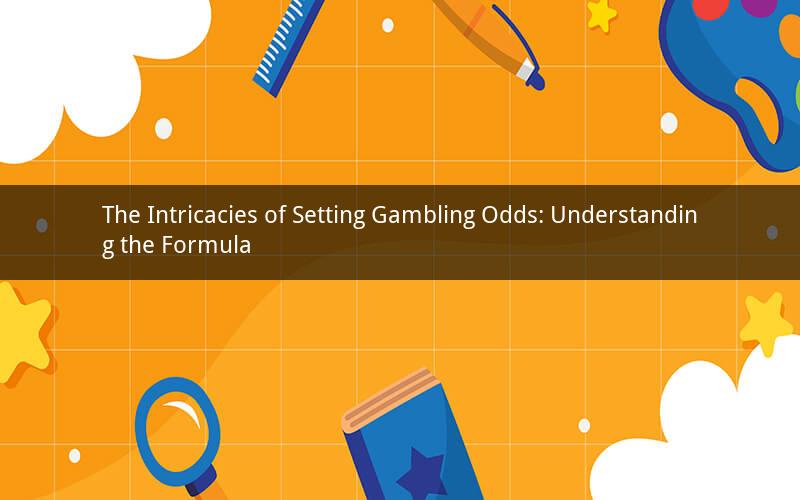
Gambling odds play a pivotal role in the world of gambling, as they determine the likelihood of an event occurring and the potential payout for players. But how are these odds set? In this article, we will delve into the intricacies of setting gambling odds, exploring the methods and formulas used by bookmakers and casinos. By understanding the process, players can gain insight into the odds of winning and make more informed decisions when placing bets.
1. Factors Influencing the Setting of Gambling Odds
The process of setting gambling odds involves considering various factors to ensure fairness and profitability for both players and operators. Here are some of the key factors:
a. Historical Data: Bookmakers analyze historical data of past events to predict the likelihood of similar events occurring in the future. This data helps in determining the odds for a particular outcome.
b. Expert Knowledge: Bookmakers and analysts often possess extensive knowledge of a particular sport or game, which enables them to provide accurate odds based on their expertise.
c. Market Conditions: Odds can be adjusted based on market conditions, such as the popularity of a particular sport or game. For instance, a high-profile event like the World Cup may result in increased betting activity, leading to adjustments in odds.
d. Risk Assessment: Operators must assess the potential risks associated with each bet to ensure that they can sustain losses and continue offering betting services.
2. Types of Betting Odds
There are three main types of betting odds used in the gambling industry: decimal odds, fractional odds, and American odds. Understanding these formats is essential for players to compare odds and make informed decisions.
a. Decimal Odds: Decimal odds are the most common format used in Europe. They represent the total return on a bet, including the stake. For example, an odds of 2.50 on a bet means that for every $1 wagered, the player will receive a total of $2.50 in return, including their original stake.
b. Fractional Odds: Fractional odds are popular in the United Kingdom and Ireland. They represent the potential profit on a bet relative to the stake. For instance, odds of 5/1 on a bet mean that if the bet wins, the player will receive $5 in profit for every $1 wagered.
c. American Odds: American odds are commonly used in the United States. They can be both positive and negative, with positive odds indicating the potential profit on a bet and negative odds indicating the amount required to win $100. For example, +200 odds on a bet mean that a player would receive $200 in profit for every $100 wagered, while -150 odds mean a player must wager $150 to win $100.
3. Calculating Gambling Odds
The process of calculating gambling odds involves several steps, including:
a. Identifying the Event: The first step is to identify the event on which you want to place a bet. This could be a sports match, a horse race, or a political election.
b. Estimating the Likelihood: Next, estimate the likelihood of each possible outcome. This can be based on historical data, expert knowledge, and market conditions.
c. Calculating the Probability: Convert the likelihood of each outcome into a probability. For example, if you believe there is a 50% chance of an event occurring, the probability would be 0.5.
d. Setting the Odds: Use the probability to calculate the odds for each outcome. For instance, if an event has a 50% probability of occurring, the odds would be 1 to 1 or 2.00 in decimal format.
4. Bookmaker Profit Margins
Bookmakers must ensure that they make a profit while offering betting services. This is achieved by setting odds that slightly favor the bookmaker, known as the "overround" or "vigorish."
a. Overround: The overround is the percentage of money that the bookmaker expects to lose on a particular market. For example, a bookmaker with a 10% overround would expect to lose 10% of the total stakes placed on a market.
b. Calculating the Overround: To calculate the overround, add up the implied probabilities of all possible outcomes in a betting market. Divide this sum by the number of possible outcomes to get the overround percentage.
c. Adjusting Odds: Bookmakers adjust their odds to account for the overround, ensuring they can cover potential losses while still remaining competitive.
5. Conclusion
Understanding how gambling odds are set can provide players with valuable insight into the likelihood of winning and the potential profit on their bets. By considering factors such as historical data, expert knowledge, market conditions, and bookmaker profit margins, players can make more informed decisions and increase their chances of success in the world of gambling.
Questions:
1. What are the three main types of betting odds used in the gambling industry, and how do they differ from one another?
2. How do bookmakers use historical data to set gambling odds?
3. What is the difference between implied probability and actual probability?
4. How does the overround affect the profitability of bookmakers?
5. Can players manipulate gambling odds to their advantage? If so, how?